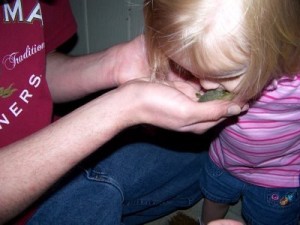In August 2015, the U.S. Food and Drug Administration (FDA) notified the U.S. Center for Disease Control of a consumer complaint involving Salmonella Sandiego infection in a child (the index patient), who had acquired a small turtle (shell length <4 inches [<10 cm]) at an Alabama flea market. The subsequent investigation, which included examining data from PulseNet, the national molecular subtyping network for foodborne disease surveillance, identified four multistate Salmonella outbreaks: two involving Salmonella Sandiego and two involving Salmonella Poona. These  serotypes have been linked to small turtles in previous outbreaks (1,2).
serotypes have been linked to small turtles in previous outbreaks (1,2).
Although selling small turtles as pets in the United States has been banned since 1975 (3), illegal sales still occur at discount stores and flea markets and by street vendors. CDC investigated to determine the extent of the outbreaks and prevent additional infections.
For this investigation, a case was defined as infection with Salmonella serotypes Sandiego or Poona with the pulse-field gel electrophoresis patterns XbaI JL6X01.0104, JL6X01.0544, JL6X01.0055, JLXX01.0030, or JLXX01.0053 in a person with illness onset January 1–December 31, 2015. A total of 124 cases from 22 states were identified. Median patient age was 7 years (range <1–82 years); 51 patients (41%) were aged <5 years, and 59 (49%) were female. Among 108 patients with available information, 36 (33%) were hospitalized. Thirteen (36%) of the 36 hospitalized patients were aged <5 years. No deaths were reported. Fifty-eight (70%) of 83 patients with ethnicity information were Hispanic.
A total of 104 patients or their caregivers were interviewed; 50 patients (48%) had turtle exposure. Among the 50 patients with reported turtle exposure, the median age was 3 years (range <1–77 years), 30 (60%) were aged <5 years, and 25 (50%) were female. Of the 50 patients with turtle exposure, 48 had information on hospitalization; 18 of the 48 (38%) were hospitalized. Nine of those hospitalized were aged <5 years. Twenty-eight (72%) of 39 patients with ethnicity information were Hispanic. Turtle and turtle environment samples were collected from nine patients’ homes. Of these, 21 isolates of Salmonella were culture-positive: 17 matched the outbreak strains, two were Salmonella Paratyphi B var L-tartrate+, and two were Salmonella Pomona (Table).
An FDA consumer safety officer investigating the flea market where the index patient’s turtle was obtained traced the turtle’s origin to farm A (FDA’s Center for Veterinary Medicine did not pursue legal action regarding the sale by farm A of small turtles to the flea market vendor). Pond water samples from farm A yielded cultures of Salmonella (Table). Although the samples from turtle farm A did not yield the 2015 outbreak strains, two of the three Salmonella Pomona isolates from pond water matched isolates from a patient’s pet turtle’s environment.
The high proportion of patients aged <5 years in these outbreaks emphasizes the risk for illness among young children with small turtles as pets. This finding indicates education is needed to address the risk to children for Salmonella infections from small turtles and other reptiles. Many patients in these outbreaks were Hispanic, which highlights the importance of multilingual messages for effective communication. During these outbreaks, the announcement and prevention messages regarding safe handling of pet reptiles and amphibians were translated into Spanish and posted on the “CDC en Español” website. To ensure wider dissemination, information was also provided to a major Spanish-language news agency.
Transient vendors continue to be a source of illegal sales of small turtles. Educational campaigns at schools, child care centers, carnivals, and flea markets regarding the risk for Salmonella from contact with turtles are important to prevent infections among children.
